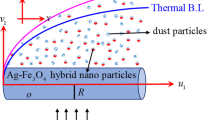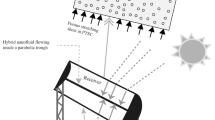Abstract
Ionic liquid-based nanofluids are a very novel group of fluids used for enhancing heat transfer in different applications, especially in solar energy ones where the parabolic trough pipe receiver is subjected to heat flux due to the sun beam radiation. In regard to this new class of fluids, no empirical correlations are available for their heat transfer capabilities inside tubes even if some research on local Nusselt number of regular flow is present in the current literature. This paper introduces new correlation for heat transfer and friction factor in pipes subjected to constant heat flux considering [C4mim] [NTf2] ionic liquid-based nanofluids flow. In addition, the performance evaluation criteria as an optimization parameter between heat transfer enhancement and pressure drop penalty have been evaluated. In this particular application, the flow is laminar, as recommended in low heat flux applications (solar beam radiation), with Reynolds number in the range of 100–2000 and nanoparticles volume concentration varying from 0 to 2.5%. In addition, according to the change in the [C4mim] [NTf2] ionic liquid thermophysical properties with temperature, the Prandtl number consequently has been changed. As an overall conclusion, the proposed correlations can be seen as favorable for the heat transfer enhancement estimation of the parabolic trough for the solar energy applications. Finally, this pioneering class of heat transfer fluids (ionic liquid-based nanofluids) reveals a great potential in advanced heat transfer applications; therefore, the new correlations aim to collaborate to this progress.










Similar content being viewed by others
Abbreviations
- C P :
-
Specific heat (J kg−1 K)
- D :
-
Pipe inside diameter (m)
- f :
-
Friction factor
- Gz :
-
Graetz number
- h :
-
Average heat transfer coefficient (W m−2 K)
- k :
-
Fluid thermal conductivity (W m−1 K)
- L :
-
Pipe length (m)
- Nu :
-
Nusselt number
- P :
-
Pressure (N m−2)
- P :
-
Dimensionless pressure
- PEC :
-
Performance evaluation criteria
- Pr :
-
Prandtl number
- q :
-
Heat flux (W m−2)
- r o :
-
Pipe inside radius (m)
- r :
-
Radial coordinate (m)
- R :
-
Radial dimensionless coordinate
- Re :
-
Reynolds number
- T :
-
Local temperature (K)
- T b :
-
Bulk temperature (K)
- T w :
-
Wall temperature (K)
- u :
-
Velocity components in r direction
- v :
-
Velocity components in z direction
- U :
-
Dimensionless velocity component in R direction
- V :
-
Dimensionless velocity component in Z direction
- Z :
-
Longitudinal dimension coordinate (m)
- Z :
-
Longitudinal dimensionless coordinate
- α :
-
Thermal diffusivity (m2 s−1)
- ϕ :
-
Volume concentration
- θ :
-
Dimensionless temperature
- μ :
-
Dynamic viscosity (kg m−1 s)
- ν :
-
Kinematics viscosity (m2 s−1)
- ρ :
-
Local density (kg m−3)
- f:
-
Base fluid
- ionano:
-
Ionanofluids
- ∞:
-
Inlet to pipe
References
Shahrul IM, Mahbubul IM, Khaleduzzaman SS, Saidur R, Sabri MFM. A comparative review on the specific heat of nanofluids for energy perspective. Renew Sustain Energy Rev. 2014;38:88–98.
Liu J, Wang F, Zhang L, Fang X, Zhang Z. Thermodynamic properties and thermal stability of ionic liquid-based nanofluids containing graphene as advanced heat transfer fluids for medium-to-high-temperature applications. Renew Energy. 2014;63:519–23.
Solangi KH, Kazi SN, Luhur MR, Badarudin A, Amiri A, Sadri R, Zubir MNM, Teng KH. A comprehensive review of thermo-physical properties and convective heat transfer to nanofluids. Energy. 2015;89:1065–86.
Kakaç S, Pramuanjaroenkij A. Review of convective heat transfer enhancement with nanofluids. Int J Heat Mass Transf. 2009;52:3187–96.
Mahboobeh H, Sara SS, Hossein A, Elaheh KG. Nanofluids for heat transfer enhancement e a review. Phys Chem Res. 2013;1:1–33.
Mahian O, Kianifar A, Kalogirou SA, Pop I, Wongwises S. A review of the applications of nanofluids in solar energy. Int J Heat Mass Transf. 2013;57:582–94.
Huminic G, Huminic A. Application of nanofluids in heat exchangers: a review. Renew Sustain Energy Rev. 2012;16:5625–38.
Minea AA. Challenges in hybrid nanofluids behavior in turbulent flow: recent research and numerical comparison. Renew Sustain Energy Rev. 2017;71:426–34.
Nieto de Castro C, Lourenço M, Ribeiro A, Langa E, Vieira S, Goodrich P. Thermal properties of ionic liquids and ionanofluids of imidazolium and pyrrolidinium liquids. J Chem Eng Data. 2009;55:653–61.
Fukushima T, Kosaka A, Ishimura Y, Yamamoto T, Takigawa T, Ishii N. Molecular ordering of organic molten salts triggered by single-walled carbon nanotubes. Science. 2003;300:2072–4.
De Castro CN, Murshed SS, Lourenço M, Santos F, Lopes M, França J. Enhanced thermal conductivity and specific heat capacity of carbon nanotubes ionanofluids. Int J Thermal Sci. 2012;62:34–9.
França JMP, Nieto de Castro CA, Lopes MM, Nunes VMB. The influence of thermophysical properties of ionic liquids in chemical process design. J Chem Eng Data. 2009;54:2569–75.
França JMP. Thermal properties of ionanofluids, MSc Thesis, Faculdade de Ciências da Universidade de Lisboa, Portugal, 2010.
Paul TC, Morshed AKMM, Fox EB, Khan JA. Experimental investigation of natural convection heat transfer of Al2O3 Nanoparticle Enhanced Ionic Liquids (NEILs). Int J Heat Mass Transf. 2015;83:753–61.
Paul TC, Morshed AKMM, Fox EB, Khan JA. Enhanced thermophysical properties of NEILs as heat transfer fluids for solar thermal applications. Appl Therm Eng. 2017;110:1–9.
Bridges NJ, Visser AE, Fox EB. Potential of nanoparticle-enhanced ionic liquids (NEILs) as advanced heat-transfer fluids. Energy Fuels. 2011;22:4862–4.
Paul TC, Morshed AM, Khan JA. Nanoparticle enhanced Ionic liquids (NEILs) as working fluid for the next generation solar collector. Proced Eng. 2013;56:631–6.
Zhang L, Liu J, He G, Ye Z, Fang X, Zhang Z. Radiative properties of ionic liquid-based nanofluids for medium-to-high-temperature direct absorption solar collectors. Sol Energy Mater Sol Cells. 2014;130:521–8.
Mahian O, Kianifar A, Kalogirou SA, Pop I, Wongwises S. A review of the applications of nanofluids in solar energy. Int J Heat Mass Transf. 2013;57:582–94.
Patankar SV. Numerical heat transfer and fluid flow. New York: McGraw-Hill; 1980.
El-Maghlany WM, Abo Elazm MM, Shehata AI, Teamah MA. A novel technique for heat transfer enhancement from a horizontal heated pipe by using nanofluid restrained flow. J Taiwan Inst Chem Eng. 2016;68:338–50.
El-Maghlany WM, Abo MM. Elazm, Influence of nanoparticles on mixed convection heat transfer in an eccentric horizontal annulus with rotating inner cylinder. J Taiwan Inst Chem Eng. 2016;63:259–70.
El-Maghlany WM, Saqr KM, Teamah MA. Numerical simulations of the effect of an isotropic heat field on the entropy generation due to natural convection in a square cavity. Energy Convers Manag. 2014;85:333–42.
Teamah MA, El-Maghlany WM. Numerical simulation of double-diffusive mixed convective flow in rectangular enclosure with insulated moving lid. Int J Therm Sci. 2010;49:1625–38.
Minea AA, El-Maghlany WM. Natural convection heat transfer utilizing ionic nanofluids with temperature-dependent thermophysical properties. Chem Eng Sci. 2017;174:13–24.
Paul TC. Investigation of thermal performance of nanoparticle enhanced ionic liquids (NEILs) for solar collector applications. (Doctoral dissertation). (2014). Retrieved from http://scholarcommons.sc.edu/etd/2873.
Kays WM. Convective heat and mass transfer. New York: McGraw-Hill; 1966. p. 187–90.
Akhavan-Zanjani H, Saffar-Avval M, Mansourkiaeia M, Sharif F, Ahadi M. Experimental investigation of laminar forced convective heat transfer of graphene water nanofluid inside a circular tube. Int J Therm Sci. 2016;100:316–23.
Bejan A, Kraus AD. Heat transfer handbook. New Jersey: John Wiley and Sons; 2003.
Webb RL. Performance evaluation criteria for use of enhanced heat transfer surfaces in heat exchanger design. Int J Heat Mass Transf. 1981;24:715–26.
Author information
Authors and Affiliations
Corresponding author
Rights and permissions
About this article
Cite this article
El-Maghlany, W.M., Minea, A.A. Novel empirical correlation for ionanofluid PEC inside tube subjected to heat flux with application to solar energy. J Therm Anal Calorim 135, 1161–1170 (2019). https://doi.org/10.1007/s10973-018-7461-y
Received:
Accepted:
Published:
Issue Date:
DOI: https://doi.org/10.1007/s10973-018-7461-y




